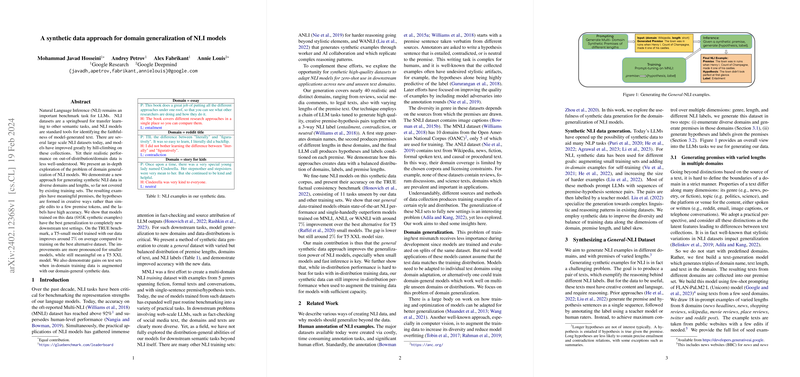A Synthetic Data Approach for Domain Generalization of NLI Models
The paper "A synthetic data approach for domain generalization of NLI models" presents a comprehensive paper focused on enhancing the domain generalization capabilities of Natural Language Inference (NLI) models through a synthetic data generation method. The primary objective is to address the suboptimal performance of NLI models on out-of-distribution or novel domain data, a persistent challenge in leveraging these models for downstream applications such as fact-checking and source attribution.
Key Contributions
The authors propose a method for generating large-scale synthetic data that encompasses a diverse range of domains and premise lengths, thereby improving the generalization power of NLI models. This approach is distinct in that it does not merely rely on minor edits to existing premise tokens. Instead, the hypotheses are creatively generated, maintaining high label accuracy.
The synthetic dataset comprises 685,000 examples spanning 40 distinct and realistic domains, including domains not traditionally covered by existing datasets. A T5-small model trained on this synthetic data showed an approximate 7% improvement in average performance on the TRUE benchmark, compared to using the best existing datasets. The improvements were not confined to smaller models, as gains were still significant for larger models like T5 XXL.
Methodology
The data generation method involves tuning LLMs to produce high-quality and creative (premise, hypothesis, label) triples across various domains. The process begins with generating domain names and then premises of varying lengths within those domains. Hypotheses and corresponding labels are subsequently generated based on these premises. The approach ensures a balanced distribution of domains, premise lengths, and labels, which contrasts with prior datasets that often suffer from stylistic or domain biases.
Evaluation and Results
The paper evaluates the synthetic dataset's impact by training NLI models from scratch using the synthetic data and comparing their performance against models trained on established datasets like MNLI, ANLI, and WANLI. The synthetic dataset's efficacy is evident as models trained using this data achieved state-of-the-art performance on the TRUE factual consistency benchmark, covering 11 diverse tasks.
Moreover, the paper explores the combination of synthetic data with existing datasets, revealing that while domain-specific data yields the highest in-domain test accuracy, augmenting these datasets with synthetic data leads to improved performance across unseen domains and distributions.
Implications and Future Directions
The research profoundly implies that synthetic data generation can be a powerful tool for mitigating the limitations of NLI models when faced with novel or diverse domain inputs. The benefits of such datasets for zero-shot learning scenarios are particularly noteworthy, showcasing potential applicability across tasks involving unseen text genres and lengths.
Future developments could explore extending this approach to other NLP tasks or languages beyond English, considering the adaptability and scalability of the synthetic dataset generation process. Additionally, Analyzing the impact of varying the scale of synthetic data, in terms of quantity and diversity, would provide further insights into optimizing model performance across multiple domains.
In conclusion, this paper underscores the potential of synthetic data to substantially enhance the domain generalization of NLI models, paving the way for broader application and robustness of NLP systems in diverse settings.
